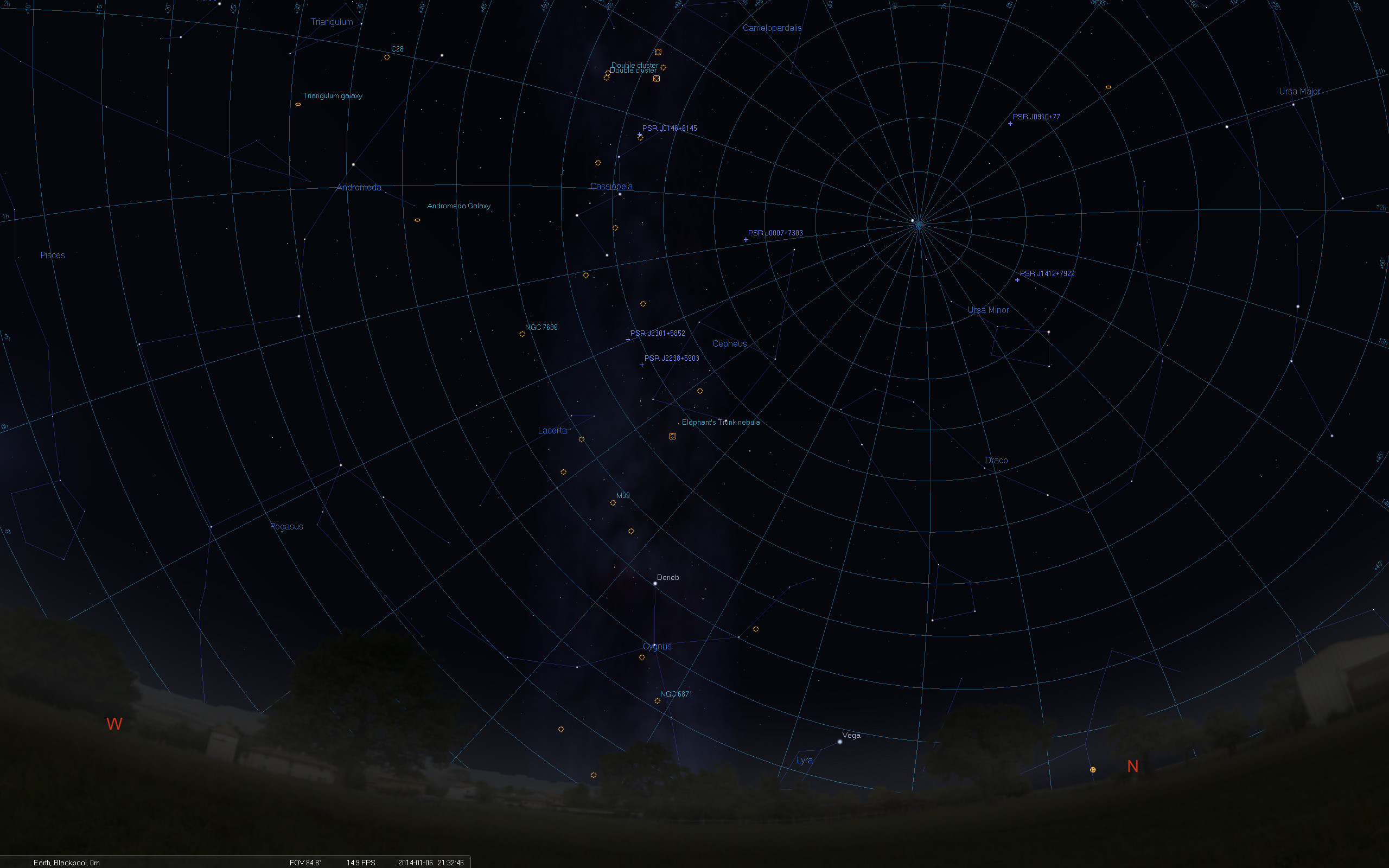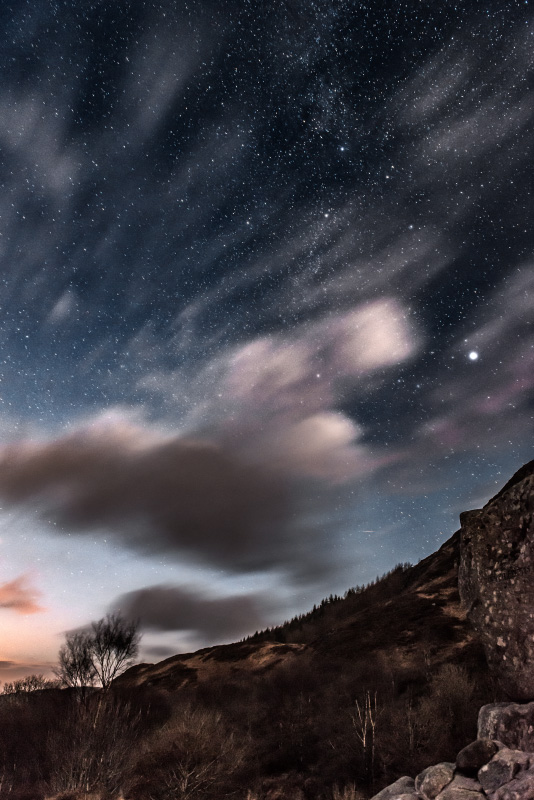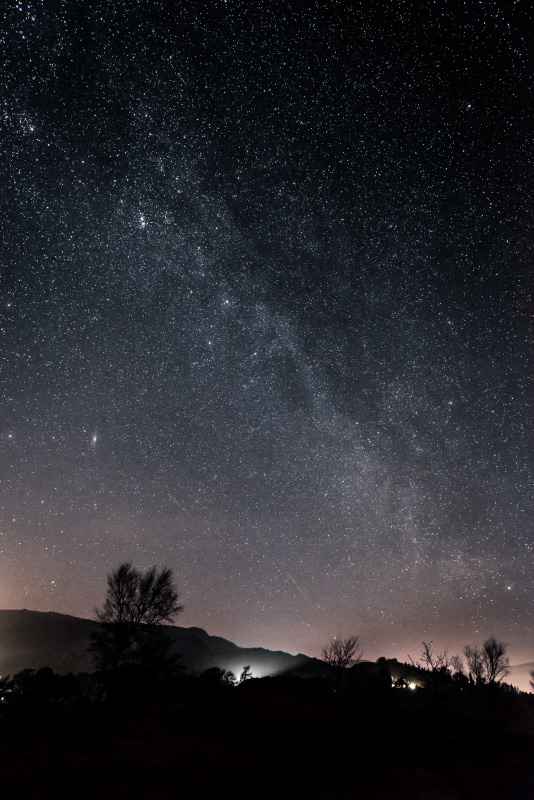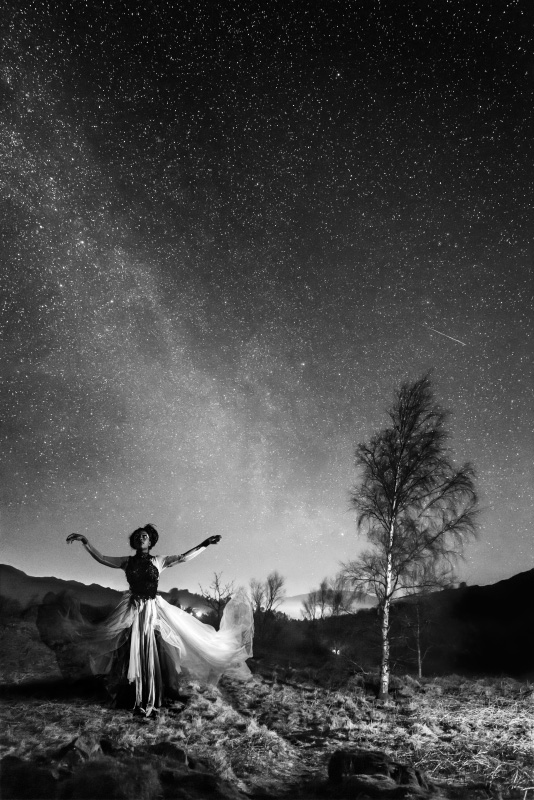and please use their services
You are using an out of date browser. It may not display this or other websites correctly.
You should upgrade or use an alternative browser.
You should upgrade or use an alternative browser.
Help with Milky Way photography
- Thread starter powell7
- Start date
- Messages
- 396
- Name
- andy
- Edit My Images
- Yes
Download a program called stellerium it shows all planetry objectslook for the constellation cassiopeia and you will see a light milky patch that is the milky way and you can follow it through the stars, It's not very promient at the moment you can see it better in summmer in a dark sky
- Messages
- 11,756
- Name
- David
- Edit My Images
- No
Here's a screen grab of Stellarium showing the Milky Way

It runs from Cygnus through Cassiopeia
This screen shot is accurate as of the time of this post. It sets soon after. Early Autumn is best for Milky Way shots, but as you can see above, part of it is still visible even in Winter. To see it at it's best you really need to be in the southern hemisphere... but that's hardly practical
At this time of year, I recommend shooting NW at around 6-7pm in a sky free of light pollution. In a true, dark sky sight (or close to it) use f2.8 ISO6400 for 25 seconds with a lens around 24mm ish. If you have lots of light pollution you will need to either stop down, use a shorter speed, or lower the ISO. You'll need to experiment around those times.
Any longer than 25 seconds, or lens longer than 24mm and you'll start t get star trails.... or use the "500" rule. Divide 500 by your focal length to give max time in seconds. e.g, 20mm lens = 500/20 = 25 seconds.

It runs from Cygnus through Cassiopeia
This screen shot is accurate as of the time of this post. It sets soon after. Early Autumn is best for Milky Way shots, but as you can see above, part of it is still visible even in Winter. To see it at it's best you really need to be in the southern hemisphere... but that's hardly practical
At this time of year, I recommend shooting NW at around 6-7pm in a sky free of light pollution. In a true, dark sky sight (or close to it) use f2.8 ISO6400 for 25 seconds with a lens around 24mm ish. If you have lots of light pollution you will need to either stop down, use a shorter speed, or lower the ISO. You'll need to experiment around those times.
Any longer than 25 seconds, or lens longer than 24mm and you'll start t get star trails.... or use the "500" rule. Divide 500 by your focal length to give max time in seconds. e.g, 20mm lens = 500/20 = 25 seconds.
Last edited:
- Messages
- 3,726
- Name
- Mark
- Edit My Images
- No
If you're somewhere truly dark once your eyes are accustomed to the dark you can usually see the Milky Way just by eye.
I've never tried this type of photography, but I'm tempted. As David said, it's a lot more visible in the Southern Hemisphere. It's very conspicuous once you get beyond the light pollution of the cities, and I've often seen it as a great 'milky' swathe across the night sky from the Drakensberg, the Karoo and various game reserves. The stars are spectacular too, and seem so much closer.
- Messages
- 396
- Name
- andy
- Edit My Images
- Yes
Not to confuse things david, can i ask where you get the 500 rule from because from all the searching on the net about astrophotography I've only seen them mention divide by 600 or 400, i been using the 600 one next time i go out i will try 500 to see what it's like, like you say you need to experiment with these things
- Messages
- 11,756
- Name
- David
- Edit My Images
- No
You've written your own answer. It's an average of the two contesting theories. I've tested "500" extensively and while it may not be scientific in it's accuracy, it MORE then suffices. Trust it... it will work.
- Messages
- 470
- Name
- Stewart
- Edit My Images
- Yes
Funny this should crop up - I am going out tonight and taking my chances on the Northern Lights appearing and it will be my first attempt at such things so have been Googling some knowledge all morning and have also come to the conclusion that 500 is the best starting point and im pretty excited to try it out tonight. Fingers crossed the Aurora is visible from my chosen location.
Last edited:
- Messages
- 1
Hi
- Messages
- 248
- Edit My Images
- Yes
I've always been able to see it anywhere that's relatively dark as long as it's clear, although that could just be a benefit of living somewhere where there's a fair bit of dark night sky. You do need to allow your eyes some time to adjust, though.
I had my first attempt at photographing it over the summer - been waiting for a clear night to try it again recently. These were done at 30mm (on NEX 1.5x crop sensor) for around 30 seconds at ISO1600 IIRC.


I had my first attempt at photographing it over the summer - been waiting for a clear night to try it again recently. These were done at 30mm (on NEX 1.5x crop sensor) for around 30 seconds at ISO1600 IIRC.


Last edited:
- Messages
- 11,756
- Name
- David
- Edit My Images
- No
I've always been able to see it anywhere that's relatively dark as long as it's clear,
The Milky Way is visible all year round, but it's far more dramatic in summer/autumn... and the best part of it is unfortunately not visible from the northern hemisphere.
I made all of these images in the UK during winter/early spring though.. if I recall correctly... certainly not summer anyway.



Last edited:
- Messages
- 10,866
- Name
- Steve
- Edit My Images
- Yes
Great images David, especially like the first and the last one is very dramatic
Steve
Steve
The Milky Way is visible all year round, but it's far more dramatic in summer/autumn... and the best part of it is unfortunately not visible from the northern hemisphere.
I made all of these images in the UK during winter/early spring though.. if I recall correctly... certainly not summer anyway.



- Messages
- 11,756
- Name
- David
- Edit My Images
- No
Loving that last one! Was that multiple exposures?
Last one is a composite... for obvious reasons.
Thanks
- Messages
- 136
- Name
- Stuart
- Edit My Images
- Yes
Great phot Drew!
Just for the clarity of how to stop stars trailing etc. If you aren't sure, there is a website here (not mine!)
http://www.howardedin.com/articles/fov.html
which will give you the sampling in arcseconds of the pixels in most DSLRs, as a function of the focal length.
All you then need to remember is that stars near the equator seem to move across the sky at 15 arcseconds
per second of time (stars at the poles don't move at all, the ones in between move at an intermediate speed).
So in 25 seconds you'd need to have pixels not much bigger than 375 arcseconds on a side for stuff down in the
south above the equator to stop it appearing extended. Change the focal length by a factor of two, change the
sampling in arcseconds by the same (longer focal length, finer sampling, fewer arcseconds per pixel). Once you
have some idea of the magic numbers for your camera it's pretty straightforward.
Just for the clarity of how to stop stars trailing etc. If you aren't sure, there is a website here (not mine!)
http://www.howardedin.com/articles/fov.html
which will give you the sampling in arcseconds of the pixels in most DSLRs, as a function of the focal length.
All you then need to remember is that stars near the equator seem to move across the sky at 15 arcseconds
per second of time (stars at the poles don't move at all, the ones in between move at an intermediate speed).
So in 25 seconds you'd need to have pixels not much bigger than 375 arcseconds on a side for stuff down in the
south above the equator to stop it appearing extended. Change the focal length by a factor of two, change the
sampling in arcseconds by the same (longer focal length, finer sampling, fewer arcseconds per pixel). Once you
have some idea of the magic numbers for your camera it's pretty straightforward.
- Messages
- 3,884
- Name
- Danny
- Edit My Images
- No
Great thread. I'm DYING to try this. Just need to find the time to set up camp somewhere with dark enough skies.
Here's a useful little article I stumbled across when researching where to go. Gives some good locations:
http://www.telegraph.co.uk/travel/a...72447/Britains-best-stargazing-locations.html
Lake District for me I reckon.
Here's a useful little article I stumbled across when researching where to go. Gives some good locations:
http://www.telegraph.co.uk/travel/a...72447/Britains-best-stargazing-locations.html
Lake District for me I reckon.
- Messages
- 845
- Name
- Omar
- Edit My Images
- Yes
Great phot Drew!
Just for the clarity of how to stop stars trailing etc. If you aren't sure, there is a website here (not mine!)
http://www.howardedin.com/articles/fov.html
which will give you the sampling in arcseconds of the pixels in most DSLRs, as a function of the focal length.
All you then need to remember is that stars near the equator seem to move across the sky at 15 arcseconds
per second of time (stars at the poles don't move at all, the ones in between move at an intermediate speed).
So in 25 seconds you'd need to have pixels not much bigger than 375 arcseconds on a side for stuff down in the
south above the equator to stop it appearing extended. Change the focal length by a factor of two, change the
sampling in arcseconds by the same (longer focal length, finer sampling, fewer arcseconds per pixel). Once you
have some idea of the magic numbers for your camera it's pretty straightforward.
So, I have a D7000 and say i'm shooting at 18mm, what does this mean to me? What exactly shall I do with the figures created here? I'm, at best, perplexed, but intrigued.
- Messages
- 11,513
- Name
- Stewart
- Edit My Images
- Yes
OK, you enter your camera type and focal length in the first set of boxes and press 'Calculate'. This will tell you that the field of view measures 66.499° by 46.861°, but the key number is the arcseconds per pixel which is 54.775.So, I have a D7000 and say i'm shooting at 18mm, what does this mean to me? What exactly shall I do with the figures created here? I'm, at best, perplexed, but intrigued.
Now the advice about star trailing is:
All you then need to remember is that stars near the equator seem to move across the sky at 15 arcseconds
per second of time (stars at the poles don't move at all, the ones in between move at an intermediate speed).
So if your view includes any stars on the celestial equator, you'll start to see trailing (on a 100% crop of your image) if your shutter speed exceeds 54.775/15 which is roughly 4 seconds. With an 8-second exposure, stars on the equator will occupy 2 pixels; in 15 seconds they'll occupy 4 pixels; and so on.
But in the real world you're doing pretty well if your stars are single-pixel points to start with, so you've probably got a bit of latitude with these figures. Another real world consideration is whether you really want/need a 16-megapixel image. You only need about 6 MP for a good print. So if you plan to sample down from 16 MP to 6 MP, you can multiply all the exposure times by sqrt(16/6) which is 1.6.
Does that help?
- Messages
- 1,147
- Name
- Lee
- Edit My Images
- No
This might be of interest
http://m.accuweather.com/en/weather...ction-to-photographing-the-milky-way/17586936
Lee.
http://m.accuweather.com/en/weather...ction-to-photographing-the-milky-way/17586936
Lee.
- Messages
- 845
- Name
- Omar
- Edit My Images
- Yes
OK, you enter your camera type and focal length in the first set of boxes and press 'Calculate'. This will tell you that the field of view measures 66.499° by 46.861°, but the key number is the arcseconds per pixel which is 54.775.
Now the advice about star trailing is:
So if your view includes any stars on the celestial equator, you'll start to see trailing (on a 100% crop of your image) if your shutter speed exceeds 54.775/15 which is roughly 4 seconds. With an 8-second exposure, stars on the equator will occupy 2 pixels; in 15 seconds they'll occupy 4 pixels; and so on.
But in the real world you're doing pretty well if your stars are single-pixel points to start with, so you've probably got a bit of latitude with these figures. Another real world consideration is whether you really want/need a 16-megapixel image. You only need about 6 MP for a good print. So if you plan to sample down from 16 MP to 6 MP, you can multiply all the exposure times by sqrt(16/6) which is 1.6.
Does that help?
Thanks very much, it does actually! I'll try putting it into practice and see what happens. Although 4 seconds doesn't seem so long! Do you need to consider crop factor when inputting the focal length on a crop sensor camera though?
- Messages
- 11,756
- Name
- David
- Edit My Images
- No
OK, you enter your camera type and focal length in the first set of boxes and press 'Calculate'. This will tell you that the field of view measures 66.499° by 46.861°, but the key number is the arcseconds per pixel which is 54.775.
Now the advice about star trailing is:
So if your view includes any stars on the celestial equator, you'll start to see trailing (on a 100% crop of your image) if your shutter speed exceeds 54.775/15 which is roughly 4 seconds. With an 8-second exposure, stars on the equator will occupy 2 pixels; in 15 seconds they'll occupy 4 pixels; and so on.
Priority one with images like this is capturing as much light as possible to keep noise to a manageable minimum. If you start getting obsessed with stars being absolute single pixels (impossible actually) then you'll find yourself shaving more and more exposure time away in this quest, especially if you have a wide view with a 14mm lens or something, as there's always going to be stars near the horizon. You'll negate all that obsessive star sharpness in your noise floor anyway. I mean, look at Drew's images above... they're at 30 seconds. Going in close you will see some slight trailing on the stars near the horizon... but does it matter? As Milky way images go, they're good. You don't see him calculating how many arc seconds the stars move
But in the real world you're doing pretty well if your stars are single-pixel points to start with, so you've probably got a bit of latitude with these figures.
I'm quoting this just to make it clear I wasn't having a go at Stewart here... he's right... don't get obsessed... there's a LOT of latitude. Brighter magnitude stars will flare out over around 5 pixels anyway... sometimes more. Look at Vega in that first image I posted... that's not post processing.... it just flared like that... it's a bright star. It looks like a golf ball!.... I think it looks cool though.
Another real world consideration is whether you really want/need a 16-megapixel image. You only need about 6 MP for a good print.
Depends how big you want to print, but yeah, reducing the res if you don't need anything massive, and specially if it's intended for screen will help a great deal.
Last edited:
- Messages
- 395
- Name
- Kevin
- Edit My Images
- Yes
This is a good site for finding the darkspots
http://www.avex-asso.org/dossiers/pl/uk/index.html
Great pictures Drew.
I can never get mine to look 'cosmic-y' like that with the cloudy parts really showing up. I'm waiting for a clear moonless night to try again this year though.
http://www.avex-asso.org/dossiers/pl/uk/index.html
Great pictures Drew.
I can never get mine to look 'cosmic-y' like that with the cloudy parts really showing up. I'm waiting for a clear moonless night to try again this year though.
- Messages
- 11,756
- Name
- David
- Edit My Images
- No
I can never get mine to look 'cosmic-y' like that with the cloudy parts really showing up. I'm waiting for a clear moonless night to try again this year though.
You need a really true dark sky site for that. Drew, as he said, was on the Pembs coast.... it's really dark down there
- Messages
- 395
- Name
- Kevin
- Edit My Images
- Yes
I've got friends in Swansea. Maybe I'll have to see if they're up for being a stop over point for a trip out there.You need a really true dark sky site for that. Drew, as he said, was on the Pembs coast.... it's really dark down there
- Messages
- 11,756
- Name
- David
- Edit My Images
- No
The very end of the North Wales Penninsula is great too... around Abadaron. That's a true dark sky site away from the villages. Galloway forest too, for those north of the border. Get away from towns like Newton Stewart and head into the forested areas and it's astonishingly dark. Most of the Lake District isn't dark enough IMO. Those shots I posted up were in the Lakes. Those cloudy parts of the galaxy are very, very faint, and if the light pollution is brighter than them, you'll never get them no matter how much processing you try to do on the images.
The truth is.... there aren't many places in the UK left that are true dark sky sites
Bit tricky doing Milky way shots if other photographers nearby are blasting coloured light/flash around because they're light painting!
The truth is.... there aren't many places in the UK left that are true dark sky sites
I might set a thread up for a night meet at the elan valleys once it gets a little warmer. Can do light painting, star trails and aim for Milky Way shots too if anyone's interested?
Bit tricky doing Milky way shots if other photographers nearby are blasting coloured light/flash around because they're light painting!
Last edited:
- Messages
- 895
- Name
- Ben
- Edit My Images
- Yes
The truth is.... there aren't many places in the UK left that are true dark sky sites
Bit tricky doing Milky way shots if other photographers nearby are blasting coloured light/flash around because they're light painting!
The elan valleys are in the process of applying for dark skies status and it looks like they're going to get it.
I'm sure we could do light painting early in the evening and star trails afterwards once its darker.
- Messages
- 11,756
- Name
- David
- Edit My Images
- No
- Messages
- 4,346
- Name
- Martin
- Edit My Images
- Yes
This is probably a bit nooby but I refer to the 500 rule above, about dividing 500 by the focal length to avoid start trails. Is this the ACTUAL focal length of the lens or the effective focal length? What I mean is, if I use a 50mm Nikon FX lens on a DX camera the effective focal length is 75mm, so do I divide 500 by 50, 75mm? My guess is 75, yes?
MWHCVT
In Memoriam
- Messages
- 28,467
- Name
- Matthew
- Edit My Images
- Yes
This is probably a bit nooby but I refer to the 500 rule above, about dividing 500 by the focal length to avoid start trails. Is this the ACTUAL focal length of the lens or the effective focal length? What I mean is, if I use a 50mm Nikon FX lens on a DX camera the effective focal length is 75mm, so do I divide 500 by 50, 75mm? My guess is 75, yes?
Yeah you use the effective focal length/35mm focal length
- Messages
- 172
- Name
- Chris
- Edit My Images
- No





